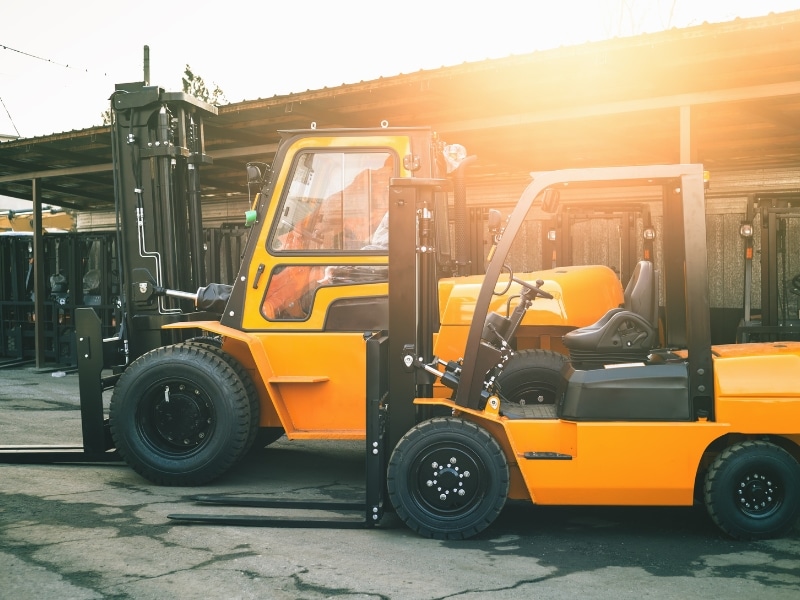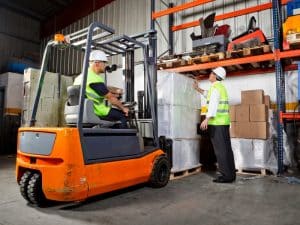Getting the right forklift skills isn’t just about knowing the basics. When the stakes are high and the environment is unpredictable, operators need more than a licence; they need agility, sharp judgement, and high-pressure decision-making. Whether you’re managing narrow aisles, handling hazardous materials, or navigating poor visibility, the difference between safe practice and serious incident comes down to the operator’s real-world capabilities. This article explores which forklift skills are critical in high-risk environments and how to build them effectively.
What are the legal requirements to get a forklift ticket?
Before operators can work in high-risk zones, they must meet specific legal licensing standards. In Australia, operating a forklift requires a High-Risk Work Licence (HRWL), which is governed by each state’s work safety authority. To apply, candidates must complete an accredited training course and pass both theory and practical assessments. The training includes:
- Load handling and stability principles, ensuring operators understand load limits, balancing, and centre of gravity management.
- Safe work procedures in warehouse or outdoor settings, including navigating slopes, blind spots, and shared spaces.
- Pre-start checks and hazard identification, with detailed inspection of brakes, tyres, forks, and warning systems.
- Emergency procedures and shutdown processes include managing mechanical failure or environmental hazards.
For individuals aiming to operate in complex conditions, it’s essential to explore certified training options for a forklift ticket that go beyond the basic requirements and include scenario-based practice.
Why do operators with poor forklift skills pose safety risks?
Operators who lack depth in their forklift skills can unintentionally create dangerous situations. Poor judgment, inadequate load control, or misjudging clearances are common issues that lead to serious accidents on-site. Even simple tasks can become risky when:
- Loads are unstable or obstruct the operator’s vision, reducing their ability to see pedestrians or signage.
- Operators ignore centre of gravity principles, increasing the likelihood of tip-overs on uneven surfaces.
- Speed is not adjusted for terrain or surroundings, particularly in tight or cluttered spaces.
- Fatigue leads to delayed response times, making it harder to react in emergencies.
These behaviours increase the likelihood of tipping, collision, or dropping loads. A solid base of knowledge, combined with on-the-job confidence, drastically reduces these risks.
How do forklift skills affect safety in hazardous job sites?
High-risk environments demand heightened situational awareness. These areas may include loading docks, narrow racking aisles, or chemical storage zones. In such settings, your forklift skills aren’t just technical — they’re tactical. Strong skills support:
- Controlled movement in congested spaces, minimising the risk of striking shelves, infrastructure, or personnel.
- Quick adaptation to shifting loads or unstable ground, especially during poor weather or in temporary site setups.
- Accurate placement of goods under pressure, crucial when stacking loads in limited time frames or confined zones
- Maintaining load integrity on uneven surfaces, reducing product damage, and workplace disruption.
To reduce incidents in these areas, operators must understand and follow workplace safety measures for handling forklifts, especially when fatigue, distractions, or noise are present.
Which forklift ticket courses focus on risk-heavy scenarios?
Standard forklift courses cover the basics, but not all dive into high-risk conditions. If you’re eyeing work in logistics hubs, ports, or mining sites, your training needs to match those risks.
Some advanced courses include:
- Realistic hazard simulation and obstacle navigation, allowing you to practise skills in controlled yet challenging settings.
- Emergency manoeuvring under time pressure, which helps develop calm, efficient responses when things go sideways.
- Advanced load calculations and placement, focusing on less predictable and more dynamic load types.
- Case studies from past on-site incidents, offering practical insights into what went wrong and why.
These types of programs help you understand how forklift training reduces accident risks on-site by addressing the specific challenges operators face beyond standard procedures.
How can training improve forklift skills under pressure?
Training that mimics real-life challenges builds resilience. It allows operators to practise difficult moves, navigate urgent deadlines, and build muscle memory. This kind of preparation boosts safety and performance. Effective training for high-risk pressure includes:
- Timed loading/unloading drills, encouraging faster, more accurate decision-making.
- Simulations involving poor visibility or wet surfaces, improving traction judgement and control.
- Stress-response assessments, testing how operators handle alarms, distractions, or conflicting priorities.
- Collaborative drills with other machinery operators enhance communication and situational awareness.
Here’s how key high-risk training areas translate to on-site safety:
| Forklift Training Focus | Risk Factor Addressed | Real-World Safety Benefit |
| Load height judgement and stacking drills | Overloading, load shift | Reduces falling objects and pallet collapse |
| Emergency braking and reaction timing | Delay in critical response | Improves hazard avoidance under sudden conditions |
| Hazard perception in obstacle environments | Blind spots, uneven terrain | Boosts operator navigation accuracy and foot traffic safety |
| Confined space manoeuvring | Equipment collisions, tight spacing | Minimises property damage and pedestrian impact risks |
The difference shows when something goes pear-shaped. Calm responses and smart decisions can prevent chaos and injury.
What forklift skills are tested in high-risk conditions?
High-risk conditions test more than your technical know-how. They test your awareness, timing, and adaptability. These are the scenarios where formal knowledge meets gut instinct — and there’s no room for error. Essential skills under pressure include:
- Judging turning radius in tight clearances is a critical skill in narrow aisles and compact warehouses.
- Balancing load and speed while reversing, especially when sight lines are limited or the terrain is uneven.
- Reading floor conditions and making quick adjustments, such as avoiding wet patches or soft surfaces.
- Coordinating with spotters or other vehicles, particularly in busy or multi-machine environments.
When these skills fall short, the consequences can be dire. That’s why it’s worth reviewing the leading factors that contribute to forklift-related accidents — most are preventable with proper skill development and refresher training.
Is a forklift ticket sufficient for high-risk operations?
Holding a forklift ticket means you’ve met the minimum standard — but that’s rarely enough in high-risk work. Additional site-specific inductions, mentoring, and practice in unpredictable settings are vital for success. Operators working in high-risk sites benefit from:
- Ongoing skill audits and refreshers, ensuring techniques don’t slip into unsafe habits.
- Shadowing experienced operators in live settings, offering first-hand exposure to real-time challenges.
- Detailed briefings before working in new zones, helping operators adjust to new rules, layouts, or hazards.
- Understanding of site-specific safety protocols, including evacuation routes, PPE requirements, and risk hotspots.
Final thoughts
Working in high-risk environments isn’t about ticking a box — it’s about knowing you can handle whatever’s thrown your way. By investing in real-world skill development, understanding your limits, and respecting the dangers on-site, you become a safer, more valuable operator. Whether you’re new to the field or levelling up, get in touch with SafeZone Training to discuss your training needs and ensure you’re ready for any high-risk scenario.



